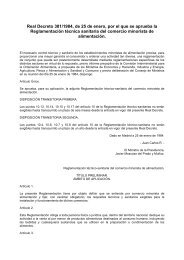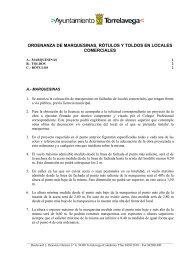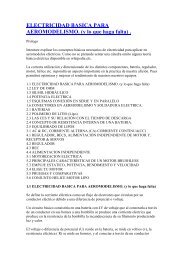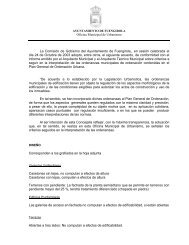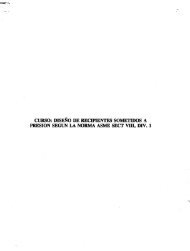Diseño para Fatiga - webaero
Diseño para Fatiga - webaero
Diseño para Fatiga - webaero
You also want an ePaper? Increase the reach of your titles
YUMPU automatically turns print PDFs into web optimized ePapers that Google loves.
9. RESUMEN FINAL<br />
• El comportamiento ante la fatiga de las<br />
uniones de sección hueca está influido en<br />
gran medida por el rango de tensión geométrica<br />
(también denominado rango de tensión<br />
del punto crítico).<br />
• Se utilizan varios análisis y métodos <strong>para</strong> el<br />
cálculo, de los que el método de la tensión<br />
geométrica o del punto crítico se considera<br />
generalmente como el más válido.<br />
• La determinación de la tensión geométrica<br />
o del punto crítico debe llevarse a cabo<br />
mediante la extrapolación al borde de la soldadura,<br />
excluyendo los efectos de la geometría<br />
de la soldadura y los efectos locales<br />
en el borde de la soldadura.<br />
• Las uniones de sección hueca muestran un<br />
considerable efecto del espesor, especialmente<br />
en el caso de espesores reducidos.<br />
• Los coeficientes de concentración de tensiones<br />
deben utilizarse con cautela (únicamente<br />
dentro del campo de validez de las<br />
fórmulas <strong>para</strong>métricas)<br />
• El método de clasificación puede utilizarse<br />
únicamente <strong>para</strong> las uniones en K y en N<br />
dentro de un campo de validez limitado.<br />
• Los momentos de flexión secundarios en<br />
las vigas de celosía han de incorporarse al<br />
análisis de fatiga.<br />
10. BIBLIOGRAFÍA<br />
[1] Eurocódigo 3: “Design of Steel Structures”:<br />
ENV 1993-1-1: ENV 1993-1-1: ENV 1993-1-1:<br />
Part 1, General Rules and Rules for Buildings,<br />
CEN, 1992.<br />
[2] Steel in marine structures, Proceedings of<br />
the 2nd International ECCS Offshore<br />
Conference, Institut de Recherches de la<br />
Siderurgie Française, Paris, October 1981.<br />
96<br />
[3] Gurney, T.R.: “Fatigue of welded structures”,<br />
Cambridge, 2nd ed.<br />
[4] Van Delft, D.R.V.: “A two dimensional analysis<br />
of the stresses at the vicinity of the weld toes<br />
of welded tubular joints”, 1981, Report 6-81-8,<br />
Stevin Laboratory, Delft University of<br />
Technology.<br />
[5] Van Wingerde, A.M.: “The fatigue behaviour<br />
of T- and X-joints made of square hollow sections”,<br />
Ph.D. thesis, Delft University of<br />
Technology, 1992.<br />
[6] Noordhoek, C. and De Back, J., Eds.: Steel in<br />
Marine Structures, Proceedings of the 3rd<br />
International ECSC Offshore Conference on<br />
Steel in Marine Structures (SIMS ‘87), Delft, The<br />
Netherlands, June 15-18, 1987.<br />
[7] Marshall, P.W.: “Design of welded tubular<br />
connections: Basis and use of AWS code provisions”,<br />
Ph.D. thesis, Elsevier Applied Science<br />
Publishers Ltd., Amsterdam/London/New York/<br />
Tokio.<br />
[8] Reynolds, A.G., Sharp J.V.: “The fatigue performance<br />
of tubular joints -An overview of recent<br />
work to revise Department of Energy guidance”,<br />
4th International Symposium of Integrity of<br />
Offshore Structures, p. 261-277, Elsevier Applied<br />
Science Publishers Ltd., Amsterdam/ London/<br />
New York/Tokio. Glasgow, U.K., July 1990.<br />
[9] Wardenier, J., Mang, F., Dutta D.: “Fatigue<br />
strength of welded unstiffened RHS joints in lattice<br />
structures and Vierendeel girders”. ECSC<br />
Final Report, ECSC 7210-SA/111.<br />
[10] J. Wardenier, J.: “Hollow Section Joints”,<br />
Delft University Press, 1982, ISBN 90.6275.<br />
084.2.<br />
[11] Romeijn, A., Wardenier, J., de Komming, C.<br />
H. M., Puthli, R. S,, Dutta, D.: “Fatigue Behaviour<br />
and Influence of Repair on Multiplanar K-Joints<br />
Made of Circular Hollow Sections”. Proceedings<br />
ISOPE ‘93, Singapore.



